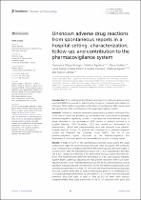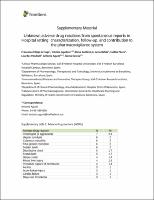| dc.contributor | Vall d'Hebron Barcelona Hospital Campus |
| dc.contributor.author | Filippi Arriaga, Maria Francesca |
| dc.contributor.author | Guillen, Elena |
| dc.contributor.author | Bellas, Lucía |
| dc.contributor.author | Pérez, Eulàlia |
| dc.contributor.author | Vendrell Bosch, Lourdes |
| dc.contributor.author | Agustí, Antònia |
| dc.contributor.author | Aguilera, Cristina |
| dc.date.accessioned | 2023-08-23T07:37:17Z |
| dc.date.available | 2023-08-23T07:37:17Z |
| dc.date.issued | 2023-07-10 |
| dc.identifier.citation | Filippi-Arriaga F, Aguilera C, Guillén E, Bellas L, Pérez E, Vendrell L, et al. Unknown adverse drug reactions from spontaneous reports in a hospital setting: characterization, follow-up, and contribution to the pharmacovigilance system. Front Pharmacol. 2023 Jul 10;14:1211786. |
| dc.identifier.issn | 1663-9812 |
| dc.identifier.uri | https://hdl.handle.net/11351/10130 |
| dc.description | Drug safety; hospital; Patient safety |
| dc.description.abstract | Introduction: Post-marketing identification and report of unknown adverse drug reactions (ADRs) are crucial for patient safety. However, complete information on unknown ADRs seldom is available at the time of spontaneous ADR reports and this can hamper their contribution to the pharmacovigilance system. Methods: In order to characterize the seriousness and outcome of unknown ADRs at the time of report and at follow-up, and analyze their contribution to generate pharmacovigilance regulatory actions, a retrospective observational study of those identified in the spontaneous ADR reports of patients assisted at a hospital (January, 2016-December, 2021) was carried out. Information on demographic, clinical and complementary tests was retrieved from patients' hospital medical records. To evaluate the contribution to pharmacovigilance system we reviewed the European Union SmPCs, the list of the pharmacovigilance signals discussed by the Pharmacovigilance Risk Assessment Committee, and its recommendations reports on safety signals. Results: A total of 15.2% of the spontaneous reported cases during the study contained at least one unknown drug-ADR pair. After exclusions, 295 unknown drug-ADR pairs were included, within them the most frequently affected organs or systems were: skin and subcutaneous tissue (34, 11.5%), hepatobiliary disorders (28, 9.5%), cardiac disorders (28, 9.5%) and central nervous system disorders (27, 9.2%). The most frequent ADRs were pemphigus (7, 2.4%), and cytolytic hepatitis, sudden death, cutaneous vasculitis and fetal growth restriction with 6 (2%) each. Vaccines such as covid-19 and pneumococcus (68, 21.3%), antineoplastics such as paclitaxel, trastuzumab and vincristine (39, 12.2%) and immunosuppressants such as methotrexate and tocilizumab (35, 11%) were the most frequent drug subgroups involved. Sudden death due to hydroxychloroquine alone or in combination (4, 1.4%) and hypertransaminasemia by vincristine (n = 3, 1%) were the most frequent unknown drug-ADR pairs. A total of 269 (91.2%) of them were serious. Complementary tests were performed in 82.7% of unknown-ADR pairs and helped to reinforce their association in 18.3% of them. A total of 18 (6.1%) unknown drug-ADR pairs were evaluated by the EMA, in 8 (2.7%) the information was added to the drug's SmPC and in 1 case the risk prevention material was updated. Conclusion: Identification and follow-up of unknown ADRs can be of great relevance for patient safety and for the enrichment of the pharmacovigilance system. |
| dc.language.iso | eng |
| dc.publisher | Frontiers Media |
| dc.relation.ispartofseries | Frontiers in Pharmacology;14 |
| dc.rights | Attribution 4.0 International |
| dc.rights.uri | http://creativecommons.org/licenses/by/4.0/ |
| dc.source | Scientia |
| dc.subject | Medicaments - Efectes secundaris |
| dc.subject | Farmacovigilància |
| dc.subject.mesh | Pharmacovigilance |
| dc.subject.mesh | Drug-Related Side Effects and Adverse Reactions |
| dc.title | Unknown adverse drug reactions from spontaneous reports in a hospital setting: characterization, follow-up, and contribution to the pharmacovigilance system |
| dc.type | info:eu-repo/semantics/article |
| dc.identifier.doi | 10.3389/fphar.2023.1211786 |
| dc.subject.decs | farmacovigilancia |
| dc.subject.decs | efectos colaterales y reacciones adversas relacionados con medicamentos |
| dc.relation.publishversion | https://doi.org/10.3389/fphar.2023.1211786 |
| dc.type.version | info:eu-repo/semantics/publishedVersion |
| dc.audience | Professionals |
| dc.contributor.organismes | Institut Català de la Salut |
| dc.contributor.authoraffiliation | [Filippi-Arriaga F, Bellas L, Pérez E, Vendrell L] Servei de Farmacologia Clínica, Vall d’Hebron Hospital Universitari, Barcelona, Spain. [Aguilera C, Agustí A] Servei de Farmacologia Clínica, Vall d’Hebron Hospital Universitari, Barcelona, Spain. Departament de Farmacologia, Terapèutica i Toxicologia, Universitat Autònoma de Barcelona, Bellaterra, Spain. Grup de Recerca de Malalties Immunomediades i Teràpies Innovadores, Vall d’Hebron Institut de Recerca (VHIR), Barcelona, Spain. [Guillén E] Departament de Farmacologia, Terapèutica i Toxicologia, Universitat Autònoma de Barcelona, Bellaterra, Spain. Department of Clinical Pharmacology, Area Medicament, Hospital Clinic of Barcelona, Barcelona, Spain |
| dc.identifier.pmid | 37492089 |
| dc.identifier.wos | 001035248500001 |
| dc.rights.accessrights | info:eu-repo/semantics/openAccess |

 Private area
Private area Contact Us
Contact Us








